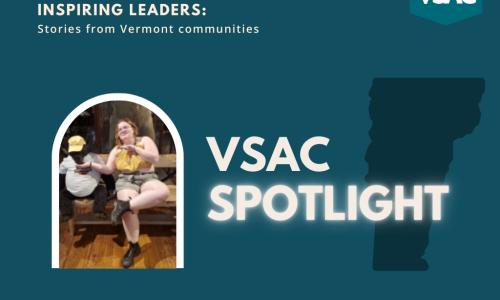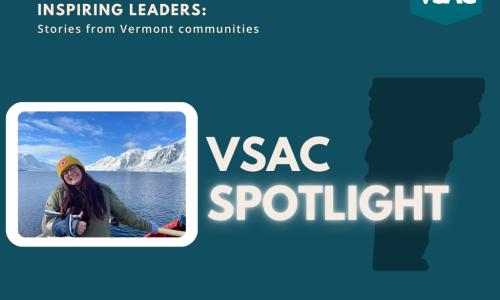Planning for college or training this year? Apply for the Vermont Grant.
How do you choose a student loan? With eyes wide open!

For many students, attending college or training after high school likely involves taking out an education loan to help cover tuition bills, along with housing, meals, books, supplies, and transportation costs. Seven out of ten Vermont families need to borrow to help pay education costs. So, if your family is considering borrowing for college expenses, you’re not alone.
Borrowing money to pay for education can feel overwhelming. But with a bit of background and some tips, you can go through the process with your eyes wide open—and before you know it, you’ll be paying your tuition bill while reducing your education costs.
Even as the current academic year winds down, bills for the spring 2025 semester will be arriving soon and parents and students will be facing important decisions. If student loans are part of your equation, check out VSAC’s My Education Loans Guide to help you get started learning the basics of borrowing. (And if you’re ready to apply for a VSAC loan, get started here!)
Apply for and accept “free” money first to reduce college expenses
Before you even consider a loan, access all your eligible “gift” money by filling out the FAFSA federal financial aid application form. After you complete the FAFSA, submit the Vermont Grant application. With both applications, you will be considered for free aid that does not need to be paid back.
After you receive your financial aid offer from your school or training program, check your tuition bill to be sure any grants and scholarships are listed as “credits.” If a grant or scholarship you received isn’t listed, call your school’s financial aid office to cross-verify the eligibility and receipt of the funds. Also, ask your financial aid office if there are any additional steps to have free aid applied to your tuition bill. If your financial situation has changed, you may be able to appeal for more aid.
What type of loan should you get? Learn about education loans so you can borrow wisely
Loans are intended to fill funding gaps after maximizing “free” money. If you need a loan to cover education costs, keep in mind: education loans are not created equal.
There are big differences between federal undergraduate student loans, federal loans for parents and graduate students, and the many variations of nonfederal (also called “private” or “alternative”) loans from your school, state agencies such as VSAC, and commercial lenders.
First Stop: Federal Direct Student Loans
Federal Direct loans will appear as part of your school’s financial aid package if you file a FAFSA. Like any loan, these must be repaid with any interest that accrues so it is important to understand the loan terms. There are two types of Federal Direct loans, Federal Direct loans that are in the student's name, and Federal Direct loans for a student that are in a parent(s) name (known as PLUS loans).
Federal Direct loans for students are in the student’s name, for students to pay back. We recommend students borrow funds using these loans first due to the flexible repayment options, such as no payments due while in school at least half time, and a six-month grace period before repayment begins. There are two types of Federal Direct loans available to students. They can be either:
- Subsidized (based on financial need). These loans don’t accrue interest while you’re in school, or in a repayment period where your loan is deferred (paused or reduced for an amount of time).
- Unsubsidized (not based on financial need). These loans start accruing interest while you are in school.
Federal Direct student loans have caps on how much you can borrow annually. If you’ve maximized your federal student loans and still have a funding gap, other types of loans are available—read on.
I’ve maximized my Federal Direct student loans. What type of loans should I consider next?
Students and families can use Federal Direct PLUS loans, or private loans, to supplement costs that remain after students take out federal student loans. The lending landscape for private loans is highly competitive among financing entities, who all are vying for your business.
Pause and compare private loans to Federal Direct PLUS loans before you sign on to any loans
Federal Direct PLUS loans are in the parent(s) name, for the parent(s) to pay back:
- Federal Direct PLUS loans are designed for parents (and graduate students) to cover up to the full remaining cost of a student’s attendance. The person taking out the loan is responsible for payments. Federal PLUS loans may be packaged with your financial aid offer, but unlike federal direct loans for students, you should pause and consider if there is a better option available before you check the box on a Federal Direct PLUS loan for parents of students.
- The Federal Direct PLUS loan for parents (not students) can have a higher rate than many other private loans. In addition, these loans currently have an origination fee. Remember, you don’t have to accept federal Parent PLUS loans and may choose to look elsewhere instead.
Private loans can be in a student’s name, or a parent(’s) name. If the loan is in the student’s name, often the lending agency will require someone with established credit, such as a parent or other person, to co-sign the loan (known as the “cosigner”).
Private loans vary greatly with each lender setting their own terms and offering different interest rates, fees, and repayment options. Remember to choose the deal that is best for you, based on three factors: interest rates, fees, and repayment.
Interest Rates
As you choose your loan, consider the full range of rates that are advertised. When shopping for a loan, people automatically look for the lowest rate—that’s natural! But each borrower will qualify for a different rate based upon their personal circumstances. It’s important for you to look at the full range of rates to make sure you’re not distracted by a rate you’re not eligible for. For instance, large national commercial lenders such as Citizens, SoFi, and Sallie Mae offer rates that, at the higher end of the rate, are almost double the annual cost of a VSAC education loan.
Rates as of March 12, 2025
Consider the type of rate as part of your review. Fixed interest rates stay the same over the life of the loan. Variable interest rates change with the financial markets (which means the rate can go up!). Variable rates may seem like a good choice at first but can end up costing a lot more over the life of a loan.
The interest rate that you will pay is based on the repayment plan you choose. Borrowers with excellent credit who choose the lowest repayment length (term) and who begin repayment immediately will have lower interest rates than those who choose a longer repayment length and who delay repayment.
Finally, beware of super-low “teaser” interest rates for which few people qualify. Never sign/approve a loan without knowing what you might ultimately pay. Determine all possible interest rates, costs, and fees and how they impact what you must repay.
Fees
Loans can have fees, either when the loan is made or when repayment starts, and you may end up being charged higher fees than the ones you saw advertised. Some lenders won’t provide complete details about their fees until after you’ve applied.
Repayment
Repayment is an important variable, which can be based on your personal circumstances. Consider when you’ll need to start repaying the loan, what the monthly payments will be, and any options for reduced or suspended payments.
Also consider when payments begin, the number of years it will take to pay the loan off (also known as term length), and whether, under the terms of the loan, you would be eligible for reduced or temporary suspension of payments due to economic hardship, working in a public service job, or income-based repayment programs.
Some loans offer repayment options to help borrowers during times of hardship. For example, VSAC offers limited suspension of payments and reduced payments. Some lenders, like VSAC, also offer free personalized education debt counseling so that when it’s time to repay the loan (or your financial circumstances change over your repayment period), you can work in partnership with your lender to come up with a plan that works for everyone.
How much should I borrow? Reduce education costs by only borrowing what you need
It’s tempting to borrow the full amount of loans to cover your education expenses, but keep in mind that all loans are borrowed money that must be paid back with interest. This means that the amount you repay will always be more than the amount you borrow. Having options can make things unclear at times. With so many student loan options, and each lender offering different rates and benefits while claiming to be your best option, here are some tips to help you make a choice.
Your goal should be to minimize loan costs as much as possible. Remember: You get to decide whether to accept some or all (or none) of the loan amounts offered in the student’s financial aid offer.
VSAC insider tips for future years
As you begin your education journey, there are a few more helpful things to keep in mind now, and for the future. VSAC’s insider tips will help your financing continue to unfold smoothly.
Leave plenty of time before your tuition bill is due to complete the loan application process
Although starting the application and getting approved may be quick, the process does require that a school certify the amount requested before the loan can be finalized. It’s recommended that you allow at least two weeks before a tuition bill is due to avoid tuition bill late fees charged by the school.
File important forms annually
Many college and training programs last for more than one academic year. Filing financial aid forms annually (FAFSA, CSS Profile, state grants, scholarships) determines your eligibility for free money and federal loans in the first year as well as in school years to come.
If you’ve borrowed more than you need, reduce your loan
Free meals at club meetings? Did you find some great prices on previously owned books? Sometimes once you get to school you realize you’re not spending as much as you thought you would. It can be hard to know exactly how much money you will need until you’re living the school experience. If you’ve borrowed more than you need, you can request the loan to be reduced. Contact your financial aid office or lender.
If you’re living off campus, consider using loans to cover housing and meals expenses
Often students move off campus after their introductory years in school. If you’re living off campus, you can use education loans to cover housing and meals expenses. Contact your school’s financial aid office.
VSAC is here to help
VSAC understands each family has unique situations making these choices challenging. For nearly 60 years we’ve served students, not shareholders. VSAC assists Vermont families in applying for as much free aid as possible while guiding them in reducing their borrowing costs. Ultimately, we want to help families understand their options so that students get the best education for the lowest cost possible, and families borrow only what they need.
Ready to research or apply for a VSAC student loan? If you’re a student attending a Vermont college, or a Vermont resident attending school anywhere, you can apply for a VSAC student loan. Have questions or need more information? Call one of our specialists at 800-226-1029, 8 a.m. to 4:30 p.m., Monday through Friday, and reach us via email at info@vsac.org.






